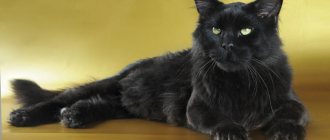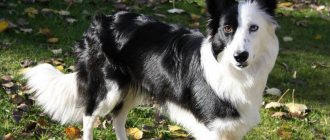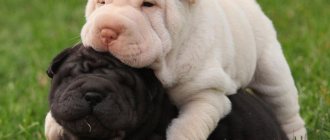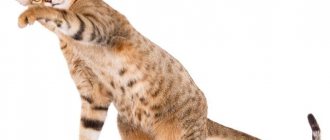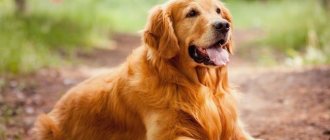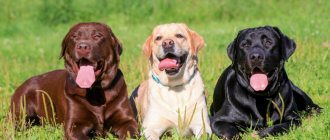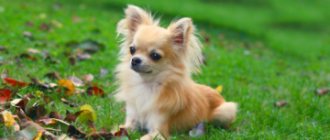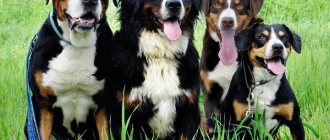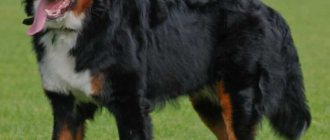Mink is a small predatory mammal from the Mustelidae family. There are 2 species - the European mink lives only in Eastern Europe. The American or eastern mink originally lived only in North America, but was brought to Europe and successfully took root. The animal is known for its beautiful, valuable fur; mink coats are especially prized.
Description and origin of the species
The European mink was first described by Swedish zoologist Carl Linnaeus in 1761, and given the scientific name Mustela lutreola.
The Latin species name Lutreola is derived from the Latin Lutra (otter) and ola (diminutive suffix) and literally means “little otter.” The Russian name “mink” was borrowed from Finnish or Estonian. According to one version, it comes from the word “nurk”, which means ermine, according to another from “nirkka”, or nirk, which translates as weasel.
The closest relatives of the European mink are the European forest ferret and the Siberian weasel. Their close relationship is confirmed by the fact that the animals easily interbreed. Despite their similar appearance, color and habits, and the common name “mink,” European and American minks are not closely related.
The North American mink was first described by German naturalist Johann Schreber in 1777, and given the scientific name Neovison vison. The American species differs from the European one at the cellular level, being closer to martens, so American mink ( Neovison) was separated into a separate genus.
The animal was introduced to Europe in the 1920s and 1930s, and successfully spread throughout the continent. The animal is gradually squeezing its European relative out of its usual habitat. The expansion of the American mink in recent decades is one of the main reasons for the extinction of the European species.
What does a mink look like?
The mink has a classic appearance for the Mustelidae family - a long, flexible, squat body and short legs. Compared to its closest relative, the Siberian weasel, the mink has a more compact body and dense build; in this sense, the animal is closer to the ferret than to martens. The animal's head is relatively large and wide, when compared with other Mustelidae, this animal is also close to the ferret. The tail of the European mink is quite short, accounting for no more than 40% of the body length, while the American species has a longer tail, up to 50% of the body length.
The average body length for male European mink is 373-430 mm, for females 352-400 mm, with a tail of about 150-190 mm. The animal weighs about 550-800 grams. The American mink is noticeably larger - body length up to 50 cm, tail length up to 25 cm, weight up to 2 kg. The paws have membranes between the toes, allowing the animal to dive and swim well. When swimming, the animal pushes with all 4 legs at the same time, and can stay under water for 1-2 minutes.
Mink fur is very thick and dense, much thicker when compared with other representatives of the Mustelidae family, but it is relatively short. The American species has much thicker, longer and softer fur, which is why it is raised on farms more than other fur-bearing animals. Since the animal is a waterfowl, there is practically no difference in length between the hair on the back and on the belly. Summer fur is slightly less dense and slightly shorter, although the difference between summer and winter fur is much less than that of land representatives of the Mustelidae family.
The color varies from reddish-brown to dark brown and even almost black. The color of the animal is uniform, although some individuals have lighter fur on the belly than on the outer parts of the body. In summer, the fur color changes to lighter with a pronounced reddish tint. The European mink has white markings on its upper lip and chin, and patches of white fur are also found on the chest and throat of some individuals. The American mink has white markings only on its lower lip.
Where does the mink live?
Back in the 19th century, the habitat of the European species of animal extended throughout Europe, from northern Spain in the west to the Ob River in the east, and from Arkhangelsk in the north to the northern Caucasus in the south. Over the past 2 centuries, the animal was exterminated by people or squeezed out by the American mink from more than 90% of its former territory.
Now the animal can be found mainly in Eastern Europe:
- Latvia
- Estonia
- Belarus
- Ukraine
- northwest and central regions of the European part of Russia
- Danube Delta in Romania
- northwestern Bulgaria
There are also small, isolated populations in northern Spain and western France. In the Vologda, Tver and Arkhangelsk regions, the animal is on the verge of extinction. The most stable and largest population is located in the Danube Delta - about 1,000 individuals; in Russia, the largest number of animals live in the Central Forest Biosphere Reserve in the Tver region. The animal is found at altitudes of up to 1120 meters at sea level.
The American mink originally lived only in North America; from the beginning of the 20th century, the animal was imported and successfully took root throughout Europe, Siberia, the Far East and Japan. Some individuals have escaped from farms and formed small wild populations in Chile, Argentina and South Africa.
As a habitat, the predator prefers small, remote flowing rivers and streams, with gentle banks overgrown with grass and trees. It is practically not found on large deep rivers; instead, it settles in their tributaries, headwaters, oxbow lakes and estuaries. It also lives in thickets of reeds and reeds on the shores of lakes, ponds, and less often in swamps.
What does a mink eat?
Mink feeds on small animals that live in water and coastal areas. The animal's diet includes:
- mouse-like rodents, mainly mice and water rats;
- crustaceans and molluscs;
- frogs, tadpoles and eggs;
- aquatic insects;
- fish - salmon, pike, gudgeon, roach, tench, perch, brown trout, eel, and others;
- birds - gulls, ducks, cormorants, moorhens, coots;
- hares and rabbits.
The American mink's diet is dominated by small mammals, especially rabbits, followed by fish and birds, most commonly moorhens and coots. The European mink feeds mainly on smaller prey - water rats, frogs, crayfish and fish weighing up to 1-1.2 kg. Unlike its more powerful American relative, the European mink rarely catches birds and practically does not hunt hares and rabbits.
The animal eats approximately 140-180 grams of animal food per day. During periods of abundance and before cold weather, the animal makes reserves for the future, depositing carcasses of frogs, fish, and small rodents in a burrow. Unlike the ferret, the mink disdains carrion and eats it only in extreme cases, after 3-4 days of fasting. The animal carries poultry, and often steals fish from fishermen when possible.
Eating habits
Photo: Iryna Mei
European minks consume a wide range of foods, mostly aquatic. Examination of the stomachs and excrement showed that they contained residues of the following food products:
- mammals (moles, water voles, muskrats, shrews);
- fish;
- frogs;
- insects;
- crayfish;
- shellfish;
- birds;
- vegetation.
Some individuals stock up on small amounts of food.
Character and lifestyle
Each animal lives in its own territory, but the size of the hunting areas is not too large compared to other representatives of the Mustelidae family, probably because there is more prey in the water than on land. The average territory of the animal is approximately 12-14 hectares; individual individuals occupy up to 60-100 hectares. Along the banks of a river or reservoir, one predator usually accounts for from 250 to 2500 meters of coastline.
The mink has one permanent den and several temporary shelters. It digs burrows on its own, preferring reed beds, old water rat holes or natural depressions. The main hole is used all year round, except during floods, and is located 6-10 meters from the water's edge.
The design of the den is quite simple, and usually consists of one or two passages with a diameter of 8-10 cm, and a length of up to 1.5 meters, leading to a nest measuring approximately 48x55 cm. The floor of the den is lined with dry grass, the hair of prey animals, moss and bird feathers. The European mink leads a more sedentary lifestyle than the American mink, and often sits out the cold in the den.
The animal is active mainly at dusk and at night, but can go hunting during the day. It searches for prey from the shore, walking about 1 km per day in summer, and about 2 km in winter. In the cold season, it prefers to move along trenches dug in the snow and rarely rises to the surface.
The animal swims beautifully, rowing with all its paws at the same time, and in case of danger it dives under the water and swims away 10-20 meters. Copes well with the current. It often hides in aquatic vegetation, holding only its muzzle above the water, and can walk along the bottom. The animal is agile and quite fast. The European mink does not climb trees well, unlike the American mink, which does not experience such difficulties.
Nutritional Features
The fish diet of the animals is determined by the year-round availability of this food resource. The predator tries to choose ice-free bodies of water for its home. In addition, the mink is an excellent swimmer and dives deeply. There is no fish - it feeds on mollusks, small rodents (even squirrels), snakes, crayfish, frogs, birds (including domestic ones) or even insects.
The animal also travels along branches and destroys bird nests. He eats only 200 g of food per day. If the hunt brought larger prey, the predator stores supplies in its shelter. If fishing is unsuccessful, it can temporarily feed on mushrooms, berries, roots or seeds. Near populated areas, wild individuals visit landfills and garbage dumps. But they rarely turn to carrion or missing meat, only in extreme cases.
Attention!
If the hunt is unsuccessful, the mink may disrupt its nocturnal lifestyle and go hunting during the day.
When raised in a cage, a furry animal is fed fish fillets, dry or wet meat-based mixtures. Mink farming is a profitable business. Just prepare good conditions for them first.
Types of mink
As of 2005, 7 subspecies of European mink were officially recognized.
- northern mink M. l.
lutreola. It lives in Finland and in the north of the European part of Russia. - French mink M. l.
biedermanni. Lives in France. - M.l. binominata
- Central European mink M. l.
cylipena. A large subspecies that lives in the Kaliningrad region, Latvia, Lithuania, Hungary and Romania. - Central Russian mink M. l.
novikovi. The animal is medium-sized, slightly larger than the northern mink, while the fur is coarser, shorter and less dense. Lives in Estonia, Latvia, Ukraine, Belarus, and in the south of the European part of Russia. - Carpathian mink Mustela l.
transsylvanica. The smallest subspecies in size, lives in the Balkans, Romania, Moldova, Bulgaria, Hungary. - Caucasian mink M. l.
turovi. Large subspecies with long fur and sparse undercoat. It is found in the Caucasus, in the lower reaches of the Volga and Don, and in eastern Ukraine.
In the wild, minks sometimes interbreed with ferrets, resulting in hybrids called honoriki. These animals are more ferret-like in appearance and habits, and travel further from the shoreline than purebred minks, although they retain the ability to swim well.
The American mink currently has 15 subspecies, depending on the animal's habitat in North America. Given the expanding habitat of the animal, there will likely be more subspecies in the future.
Reproduction and young
During the mating season, the genitals of the female European mink enlarge and change color to mauve. This animal differs significantly from the American mink, whose genitals do not change in any way during the period of estrus. During the rut, males fight for the right to mate with a female, but subsequently do not take any part in the fate of the offspring.
The mating season lasts from February to April, and the American mink always gives birth a month earlier. European mink cubs are born in April-May after 40-43 days of gestation. The American mink, like the skunk, has a unique feature - a short delay in embryo development after conception. Pregnancy of the American species lasts up to 75 days, of which the actual development of the fetus takes only 1 month. The fertilized egg does not enter the uterus immediately, but after a pause of 8 to 45 days, allowing the female to choose the best conditions for the development of the fetus.
One litter usually contains from 3 to 7 cubs, sometimes from different fathers. The puppies are born blind and weigh just 6.5 grams at birth; their weight triples in just 10 days. The eyes open after a month. At 20-25 days, European mink cubs begin to eat solid food, although the mother continues to feed them breast milk until 2-2.5 months. American minks develop faster and feed on their mother's milk for up to 5 weeks.
At the age of 56-70 days, the puppies accompany their mother on the hunt. On days 70-84, young minks become independent and leave their mother. Sexual maturity occurs at the age of 10 months, in time for the next mating season.
Popular message topics
- Life and work of Zhukovsky
Vasily Andreevich Zhukovsky was born in one of the villages of the Tula province. He was the illegitimate son of landowner A.I. Bunin. Initially, Vasily received his education in the Bunin family, after which he was sent to continue his studies at the Tula People's - About any plant from the Red Book
Of course, the snow-white water lily can be classified as a member of the Water Lily family. The usual habitat for favorable growth and development are rivers and lakes, as well as many aquatic swamps. Given a favorable environment, it can grow throughout - Artificial satellites
Some celestial bodies and satellites always revolve around our planet. Their movements and presence in the sky can be clearly seen in the evening, as well as early in the morning. Bright satellites seem to cut through the night sky, flying from one
Natural enemies
The European mink is hunted by the European tree ferret, American mink, red fox, golden eagle and great owl. Foxes generally hunt all representatives of the Mustelidae family, and actively breed in places where there are few wolves and lynxes. Therefore, the more foxes in the region, the fewer minks.
The American mink is a larger and more aggressive animal, so it is less likely to become prey to predators. However, the animal is subject to strong competition from the otter - the animals often live in the same places, which is why the American mink is forced to feed on land mammals more often, yielding fish to the otter.
Choosing a pet when purchasing
Prices for animals from the mustelid family can vary greatly. Some sellers offer predatory animals at prices starting from $50, others want $300 or more for their pets. Everything will depend on the type of mink, the quality of its wool, the popularity of the nursery and the living conditions in it. Be that as it may, the only important fact remains that the animal should be purchased only at a young age. If you buy an adult, there is a high probability that you will never be able to find a common language with your pet.
Breeding and selling minks is not as common an activity as, for example, breeding German shepherds or British cats. This is due to the popularity of these pets, which is only gaining momentum and is still at the very bottom of the ranking. The easiest purchasing option is to search for good nurseries on the Internet.
Of course, if there are nurseries in your city where mustelids are bred, this will make your task much easier. Choosing a healthy baby is not so easy, so it is better to take an experienced friend or veterinarian with you to the nursery. The cub must be mobile, active, without visible defects on the skin and musculoskeletal system. His coat and eyes should be shiny and there should be no sign of excrement under his tail.
European mink population
The European mink population is rapidly declining. According to scientists, the number of animals in the wild has decreased by 50% over the past 3 generations, and continues to decline. The decline in mink numbers in Europe began in the 18th century, when the animals disappeared from Germany, Austria and Switzerland. At the beginning of the 20th century, the animals became extinct in the Czech Republic, Poland, Bulgaria and Hungary. In Latvia, Finland and Lithuania, minks were considered extinct, but a few individuals were spotted in the 1990s. In Estonia, Belarus, Moldova and Ukraine, as well as Spain and France, by this time only small fragmented populations remained. In the European part of Russia, mink was found everywhere at the beginning of the 20th century, but the number of animals began to decline rapidly in the 1950-1960s.
The most likely reasons for the decline in the number of European mink:
- reduction of natural habitat due to river drainage and agricultural land expansion. This happened throughout the 19th - 20th centuries throughout Europe - in Germany, Russia, Moldova, Ukraine, Poland, Hungary, the Baltic countries, and others.
- excessive hunting of animals for their valuable fur, especially in Russia. At the beginning of the 20th century, 40-60,000 skins were mined per year in Russia, and about 3,000 in Finland.
- a sharp decline in the number of broad-toed crayfish . These crayfish were almost completely destroyed in Europe due to the crayfish plague.
- stiff competition from American mink. American mink was brought to Europe in 1920-1930. The American species is 20-40% larger than the European species, reproduces a month earlier, and is also not so strongly attached to the shores of reservoirs, so it is easier to adapt to changed living conditions. The number of European minks was falling even before the arrival of American minks, but fierce competition for resources and diseases brought from America accelerated the decline in the population.
Variety of breeds
Breeders have developed several breeds of mink with fur of various colors. Fur colors depend on the presence and concentration of yellow and black pigments in the animal's hairs - these factors were used by breeders to produce animals with fur of various colors.
Natural colors - black and brown are called standard, and on their basis, breeds with different colors were obtained by crossing animals.
The Canadian mink is not classified as a separate animal species. This is a breed with more valuable fur. In Canadian mink it is low-pile, velvety, silky, with a high and thick down. There is fur with super short guard hairs, resulting in the fur looking like it has been plucked.
- Cross spider
- Reptiles
- 72 facts about plants
- Animals of Siberia
- 35 facts about giraffes
- Animals of Crimea
The blue mink is represented by several breeds with blue fur. They were bred back in the 20th century, and bred on fur farms in the USSR and in other countries of Europe and America.
Blue mink fur colors come in light or dark tones, with a blue down. In the litter there are also individuals with brown or brown spots; the value of such fur is much lower.
Violet mink is considered the most valuable and beautiful among blue minks. The breed was obtained by crossing the Aleutian, Silver Blue and Malbuff breeds.
The Sapphire Mink was created by crossing the Silver Blue and the Aleutian Mink. The result was a breed with pure blue fur in dark or light tones.
The Jet breed, or black amber mink. Its description differs from other minks: its fur is black, with a dark gray down, its eyes and palate are also black.
The Royal Pastel breed has brown fur, but looks more attractive due to the brown down. The fur of minks of this breed comes in different shades of brown - from reddish to chocolate. Royal pastel minks turn gray at the age of 3-4 years, so they are not kept longer than this period.
Aleutian mink has wonderful fur; its colors form an interesting composition: black guard hair against a background of blue fluff.
The Blue Iris breed was developed by crossing blue minks with Aleutian minks. The colors of the blue iris correspond to the name of the breed.
The Hetlung breed is a pure white mink, but sometimes has a yellowish tint, which reduces the value of the skin. Females of this breed have significant disadvantages - they hear poorly and poorly monitor their babies. Caring for such an animal in captivity is quite difficult.
The American Palomino breed is distinguished by pink or greenish eyes, as well as smoky beige fur with a light blue down. There are individuals with yellow or orange undercoat; such fur is valued very low.
Protection of the European mink species
The animal is included in the international IUCN Red List as a species on the verge of complete destruction. In Russia, it is included in the Red Book of the Russian Federation and in the Red Books of a number of subjects of the Federation - Bashkiria, Udmurtia, Komi, Yamalo-Nenets Autonomous Okrug, Perm Territory, Novgorod, Pskov, Chelyabinsk, Sverdlovsk, Orenburg, Tyumen and Sakhalin regions.
The mink is protected in all countries within its habitat. Genome conservation programs are being implemented in Estonia, Spain, France, Germany, and Romania. In Russia, in the 1980s, more than 300 individuals of the European species were brought to the Kuril Islands of Kunashir and Iturup, in an attempt to save the population from the American mink, but it was not possible to obtain a stable population there.
